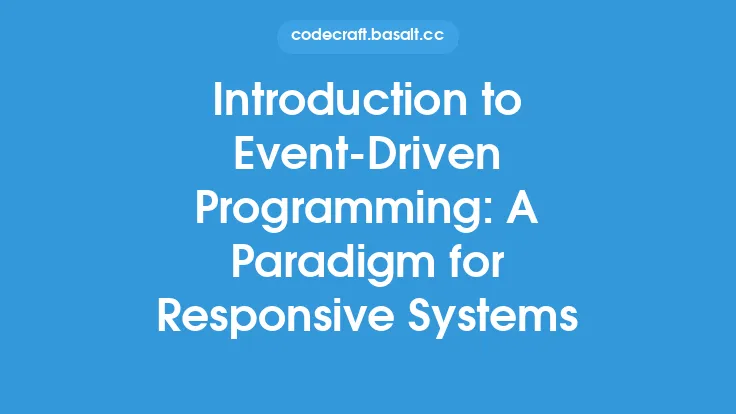Event-driven programming is a paradigm that revolves around handling and responding to events or user interactions. At the heart of this paradigm lies the concept of callbacks, which are functions that are passed as arguments to other functions and are executed by those functions. Callbacks play a crucial role in event-driven programming, enabling developers to write responsive, asynchronous, and non-blocking code. In this article, we will delve into the world of callbacks, exploring their effective use and the pitfalls to avoid.
Introduction to Callbacks
Callbacks are functions that are registered to be executed in response to a specific event or action. They are a fundamental building block of event-driven programming, allowing developers to decouple the production of events from their consumption. When an event occurs, the callback function associated with that event is executed, enabling the program to respond to the event in a timely and efficient manner. Callbacks can be synchronous or asynchronous, depending on the context in which they are used. Synchronous callbacks are executed immediately, blocking the execution of the program until they complete, while asynchronous callbacks are executed at a later time, allowing the program to continue executing other tasks.
Effective Use of Callbacks
Callbacks are a powerful tool in event-driven programming, enabling developers to write responsive and scalable code. To use callbacks effectively, developers should follow several best practices. First, callbacks should be kept simple and focused on a specific task. This makes it easier to understand and maintain the code, as well as reduces the risk of errors. Second, callbacks should be properly registered and deregistered to avoid memory leaks and unexpected behavior. Third, callbacks should be designed to handle errors and exceptions, ensuring that the program remains stable and responsive even in the face of errors. Finally, callbacks should be used in conjunction with other event-driven programming techniques, such as event loops and observers, to create a robust and scalable architecture.
Pitfalls to Avoid
While callbacks are a powerful tool, they can also be a source of complexity and errors if not used properly. One of the most common pitfalls is callback hell, which occurs when callbacks are nested too deeply, making the code difficult to read and maintain. To avoid callback hell, developers can use techniques such as promise chaining or async/await, which simplify the code and make it easier to understand. Another pitfall is the use of synchronous callbacks in asynchronous contexts, which can block the execution of the program and lead to performance issues. To avoid this, developers should use asynchronous callbacks and ensure that they are properly registered and deregistered. Finally, developers should be aware of the risk of memory leaks and unexpected behavior when using callbacks, and take steps to mitigate these risks, such as properly deregistering callbacks and using weak references.
Callbacks in Asynchronous Programming
Callbacks are particularly useful in asynchronous programming, where they enable developers to write non-blocking code that can handle multiple tasks concurrently. In asynchronous programming, callbacks are used to handle the completion of asynchronous operations, such as network requests or database queries. When an asynchronous operation completes, the callback function associated with that operation is executed, enabling the program to respond to the result of the operation. To use callbacks effectively in asynchronous programming, developers should follow several best practices. First, callbacks should be designed to handle errors and exceptions, ensuring that the program remains stable and responsive even in the face of errors. Second, callbacks should be properly registered and deregistered to avoid memory leaks and unexpected behavior. Third, callbacks should be used in conjunction with other asynchronous programming techniques, such as promises or async/await, to create a robust and scalable architecture.
Callbacks in Modern Programming Languages
Modern programming languages, such as JavaScript and Python, provide built-in support for callbacks, making it easier for developers to use them effectively. In JavaScript, callbacks are a fundamental building block of the language, and are used extensively in frameworks such as Node.js. In Python, callbacks are supported through the use of functions as first-class citizens, enabling developers to pass functions as arguments to other functions and return functions from functions. To use callbacks effectively in modern programming languages, developers should be aware of the language's built-in support for callbacks, and use it to simplify their code and improve its readability. Additionally, developers should be aware of the language's asynchronous programming model, and use it to write non-blocking code that can handle multiple tasks concurrently.
Conclusion
Callbacks are a powerful tool in event-driven programming, enabling developers to write responsive, asynchronous, and non-blocking code. To use callbacks effectively, developers should follow several best practices, including keeping callbacks simple and focused on a specific task, properly registering and deregistering callbacks, and designing callbacks to handle errors and exceptions. Additionally, developers should be aware of the pitfalls to avoid, such as callback hell and the use of synchronous callbacks in asynchronous contexts. By using callbacks effectively, developers can create robust and scalable architectures that can handle multiple tasks concurrently, and provide a responsive and engaging user experience.





